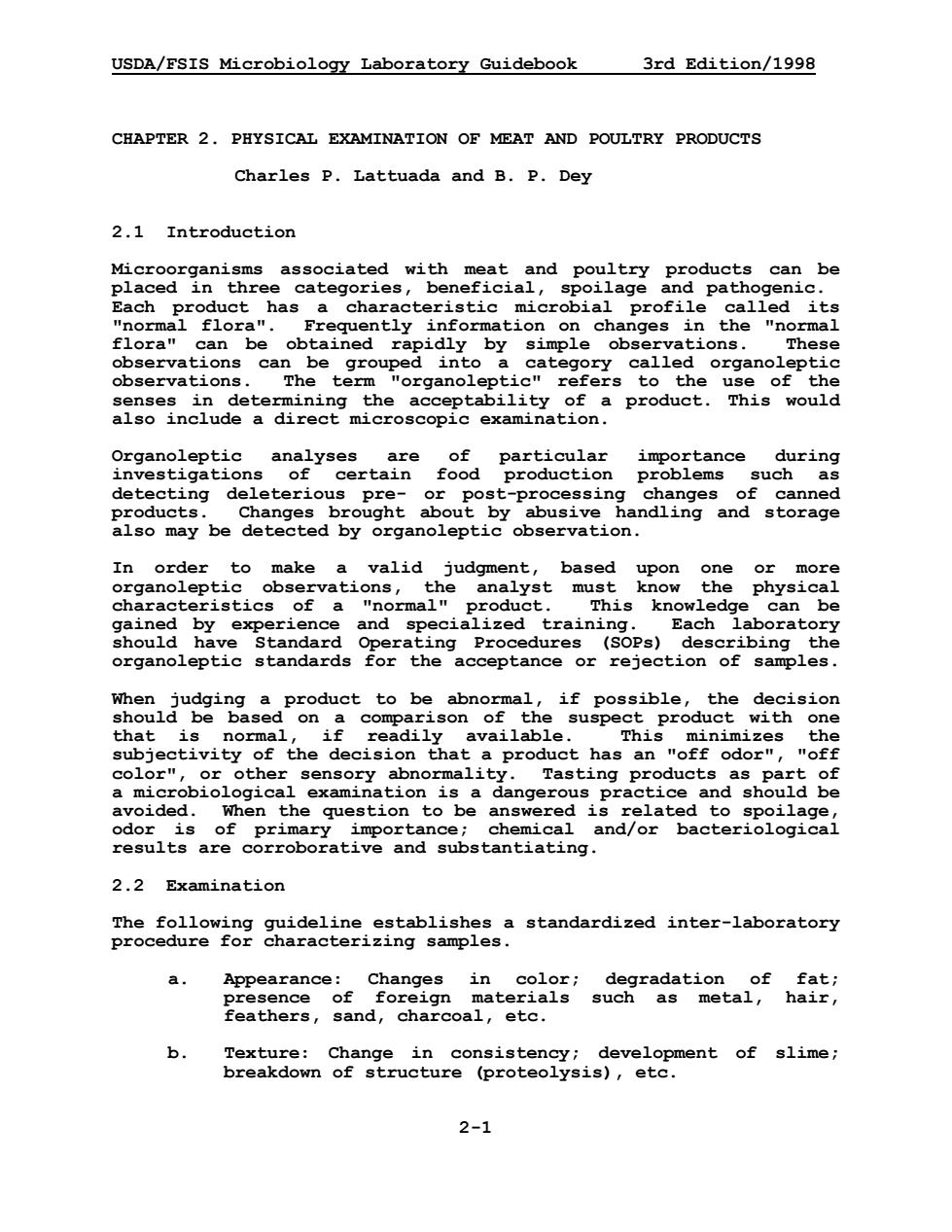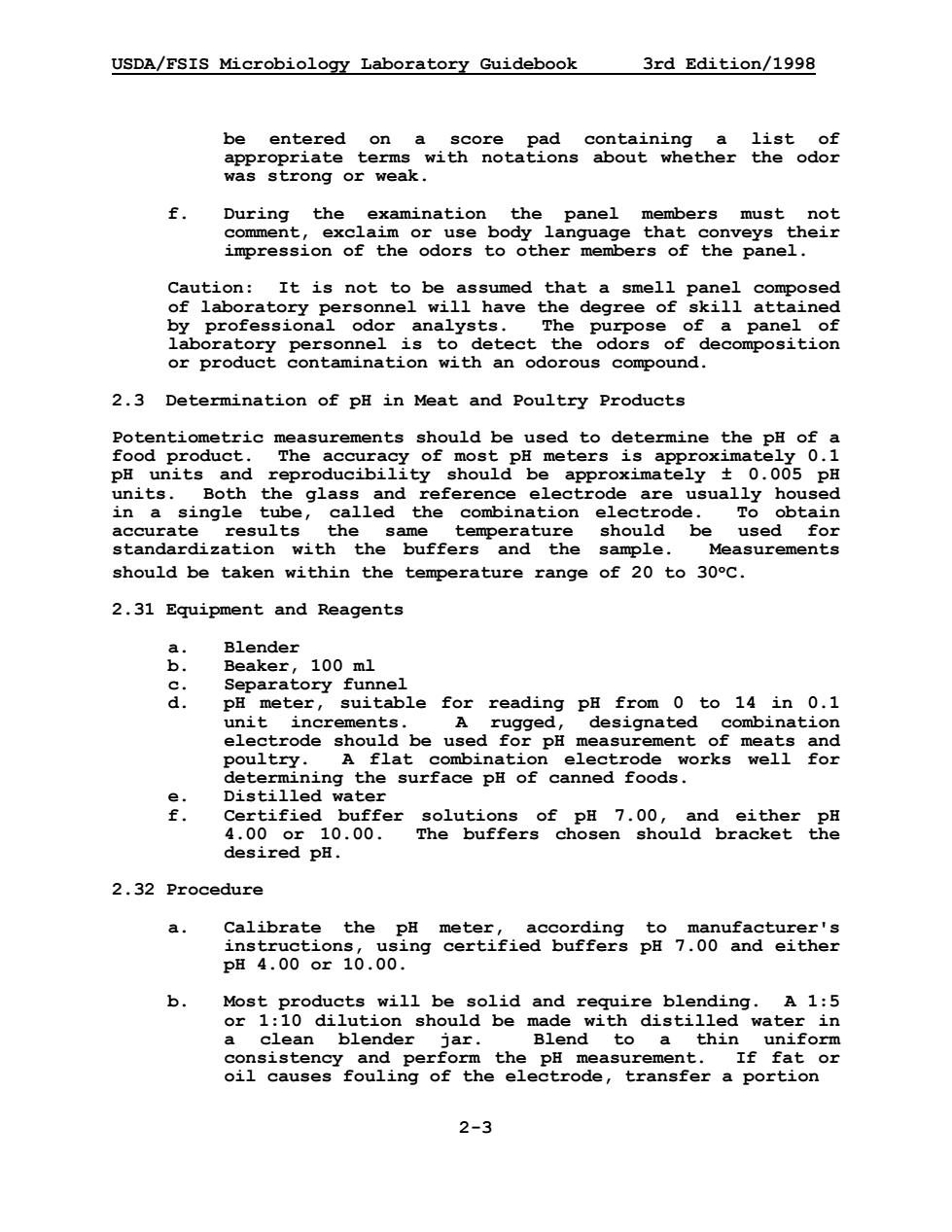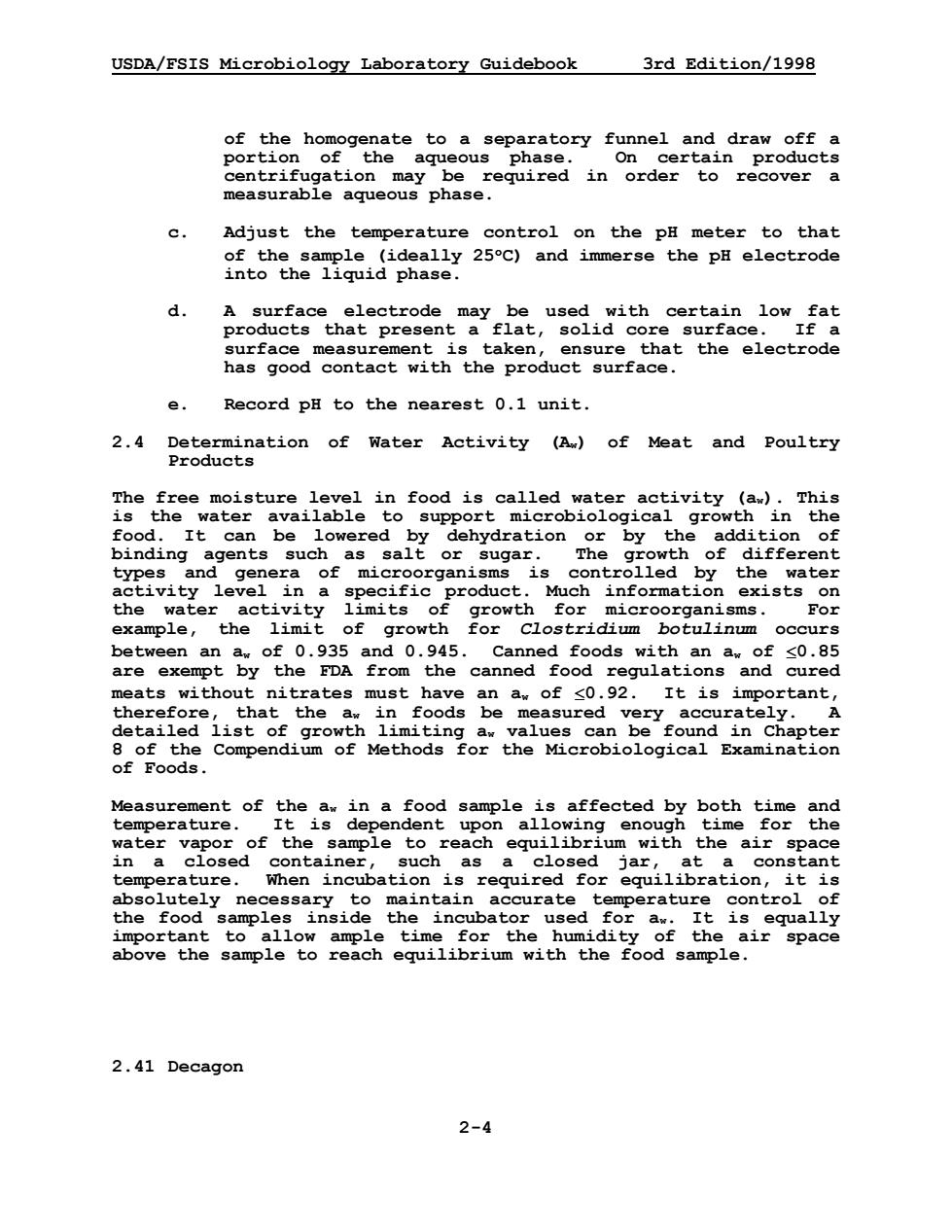
USDA/FSIS Microbiology Laboratory Guidebook 3rd Edition/1998 1.5 Cutting and Weighing Samples a. The sample should never be touched with bare hands. During the oves he ould put ng samp. b. Sterile instruments should be used for cutting,removing and manipulating all samples. c. The st be taker sampling protocol and placed in the pr container for the next processing step. The remainder of the sample vil]secured wit bold ceorain to then protooDl of the mple reserv If the sample is to clean and free of strong air currents. e. If at a11 possible for dilution,mixing, blending and/or stomachinc f. When weighing is complete, clean and disinfect the area with e product disinfe cting other materials that may have been in contact with the product must be incinerated or terminally sterilized before cleaning or disposal. 1.6 Selected References Block,S.S.(ed.).1984.Disinfection,Sterilization and Preservation,3rd Edition.Lea Febiger,Philadelphia,PA. 1-3
USDA/FSIS Microbiology Laboratory Guidebook 3rd Edition/1998 1-3 1.5 Cutting and Weighing Samples a. The sample should never be touched with bare hands. During the process of sanitizing the immediate container, the analyst should put on a pair of sterile gloves for handling samples. b. Sterile instruments should be used for cutting, removing and manipulating all samples. c. The sample must be taken aseptically according to the sampling protocol and placed in the proper sterile container for the next processing step. The remainder of the sample must be secured with an appropriate sterile closure that will preserve the sterility and integrity of the sample reserve. The sample reserve must be held according to the sampling protocol. d. If the sample is to be weighed, the balance on which samples are weighed must be placed in an area that is clean and free of strong air currents. e. If at all possible, the product should be weighed directly into the sterile container that will be used for dilution, mixing, blending and/or stomaching. f. When weighing is complete, clean and disinfect the area with the same product used initially for disinfecting the work area. All instruments, containers, gloves and other materials that may have been in contact with the product must be incinerated or terminally sterilized before cleaning or disposal. 1.6 Selected References Block, S. S. (ed.). 1984. Disinfection, Sterilization and Preservation, 3rd Edition. Lea & Febiger, Philadelphia, PA

USDA/FSIS Microbiology Laboratory Guidebook 3rd Edition/1998 CHAPTER 2.PHYSICAL EXAMINATION OF MEAT AND POULTRY PRODUCTS Charles P.Lattuada and B.P.Dey 2.1 Introduction Microorganisms associated with meat and poultry products can be Each tegor .es age a pa "normal flora". as Frequently information on changes in the "normal flora" can be obtained rapidly by simple observations. These ions can be grouped into category calle organoleptic rganol the also include a direct microscopic examination. analyses are of partic detecting products. changes brought about by abusive handling and storage also may be detected by organoleptic observation. In order to valid organoleptic observations, characteristics of a "normal" gained by experience and specialized tra This knowledge can be training. aboratory rejec When judging a product to be abnormal,if possible,the decision shoulc on with one subjectivity of the decision that a product has an "off odo","of color",or other sensory abnormality. Tasting products as part of a microbiological examin ation is a dangerous practice and should be nen he quest on results are corroborative and substantiating. 2.2 Examination Poooduo o n establishes a standardized inter-laboratory a. Appearance feathers,sand,charcoal,etc. b. Bectkd6in8e2uetur8o7eot8o2yia0redl8entots1ie own of structure (proteolysis),etc. 2-1
USDA/FSIS Microbiology Laboratory Guidebook 3rd Edition/1998 2-1 CHAPTER 2. PHYSICAL EXAMINATION OF MEAT AND POULTRY PRODUCTS Charles P. Lattuada and B. P. Dey 2.1 Introduction Microorganisms associated with meat and poultry products can be placed in three categories, beneficial, spoilage and pathogenic. Each product has a characteristic microbial profile called its "normal flora". Frequently information on changes in the "normal flora" can be obtained rapidly by simple observations. These observations can be grouped into a category called organoleptic observations. The term "organoleptic" refers to the use of the senses in determining the acceptability of a product. This would also include a direct microscopic examination. Organoleptic analyses are of particular importance during investigations of certain food production problems such as detecting deleterious pre- or post-processing changes of canned products. Changes brought about by abusive handling and storage also may be detected by organoleptic observation. In order to make a valid judgment, based upon one or more organoleptic observations, the analyst must know the physical characteristics of a "normal" product. This knowledge can be gained by experience and specialized training. Each laboratory should have Standard Operating Procedures (SOPs) describing the organoleptic standards for the acceptance or rejection of samples. When judging a product to be abnormal, if possible, the decision should be based on a comparison of the suspect product with one that is normal, if readily available. This minimizes the subjectivity of the decision that a product has an "off odor", "off color", or other sensory abnormality. Tasting products as part of a microbiological examination is a dangerous practice and should be avoided. When the question to be answered is related to spoilage, odor is of primary importance; chemical and/or bacteriological results are corroborative and substantiating. 2.2 Examination The following guideline establishes a standardized inter-laboratory procedure for characterizing samples. a. Appearance: Changes in color; degradation of fat; presence of foreign materials such as metal, hair, feathers, sand, charcoal, etc. b. Texture: Change in consistency; development of slime; breakdown of structure (proteolysis), etc

USDA/FSIS Microbiology Laboratory Guidebook 3rd Edition/1998 Odor:Examples of words used to describe off-odors are: sour (acidic),moldy,musty,fishy,rancid, fruity, yeasty (bee ce)and puts However the analys and ay simp odor"or "tain Notations as to whether the off-odor is strong or slight are also in order. 2.21 Odor Examination By a Panel In some cases results of odor examinations are equivocal and an odor detection panel,con Least pers must be oeEn his On. le with a good sense of smell can be assigned to it. The coordinator 8ii8tagP8coanrerm261lf6e prepare the samples and ensure that the a The test must be conducted in a well-ventilated area free of strong odors. b. At 15 20 the samples in che samples being examined. The normal controls should be as similar to the test product as possible with respect processing,packaging,size,age and c. All samples should be presented to the smell panel in sequentially coded glass jars bags of the same size and shape, in weight and at the same temperature (usually 35C). Both the normal and e products should be pre ente in a rand cans by since heating and/or burning the contents could aiter or mask any other odors that might be present. ouimang duthe chste normal product. They should be made aware that it is ror ge eren ce only,sinc norm r until the en of the sense of smeil which tires easily. During the actua sampled analysis,tach panel contentthout glancingatthem iff the replace the lid/clos the bag and return the container to the panel coordinator.The panelist's sensory perceptions should 2-2
USDA/FSIS Microbiology Laboratory Guidebook 3rd Edition/1998 2-2 c. Odor: Examples of words used to describe off-odors are: sour (acidic), moldy, musty, fishy, rancid, fruity, yeasty (beer-like) and putrid. However, if the analyst cannot decide how to classify an odor it is acceptable and appropriate to say simply: "off-odor" or "taint". Notations as to whether the off-odor is strong or slight are also in order. 2.21 Odor Examination By a Panel In some cases results of odor examinations are equivocal and an odor detection panel, consisting of at least three members must be formed. The purpose of this panel is to evaluate aroma only, and its judgement must not be swayed by appearances. Only people with a good sense of smell can be assigned to it. The coordinator, who is not a panel member, will prepare the samples and ensure that the following procedures are followed: a. The test must be conducted in a well-ventilated area free of strong odors. b. At least 15 - 20% of the samples in the test group should be normal, wholesome, product-counterparts of the samples being examined. The normal controls should be as similar to the test product as possible with respect to ingredients, processing, packaging, size, age and handling procedures. c. All samples should be presented to the smell panel in sequentially coded glass jars or polyethylene bags of the same size and shape, similar in weight and at the same temperature (usually 35°C). Both the normal and questionable products should be presented in a random order with a rest between samples. Do not decontaminate cans by flaming since heating and/or burning the contents could alter or mask any other odors that might be present. d. Before beginning the examination, the panel members should smell and discuss the characteristic aroma of a normal product. They should be made aware that it is for general reference only, since normal products may vary slightly in odor and intensity. They then should rest until the samples are presented to allow recovery of the sense of smell which tires easily. e. During the actual sample analysis, each panel member should remove the jar lid or open the bag, sniff the contents without glancing at them, replace the lid/close the bag and return the container to the panel coordinator. The panelist's sensory perceptions should

USDA/FSIS Microbiology Laboratory Guidebook 3rd Edition/1998 appropiate tormsntationspuhther the odo be aini was strong or weak. f. During the he 1 pane】. 、hat impression of the odors to other membero the pane It is not to hat a smell ave th by professional odor analysts. urpose of a panel of borator personnel is to otaeth or product contamination with an odorous compound. 2.3 Determination of pH in Meat and Poultry Products focentiometric measurements should be used to determine thetely 0.1 Food meters is appto efer ,111211h in a single tube,called the combination electrode. To obtain azaotthmehe258togaaE。8aepl8. accurate the temperature should be used standa Me surements should be taken within the temperature range of 20 to 30C. 2.31 Equipment and Reagents Blender 6 Beaker 100m1 uitable for reading pH from o to 14 in 0.1 unit increments. designated combination houtrodeeo e works canned e. Distilled water Certified buffer solutions of pH 7.00, 4.00or10.00. rou28gofeh8e7·89oul&bra0aerBd sired pH 2.32 Procedure a. Calibrate pi4.06ta2m10. ing cert b. A1:5 11 thi consistency and perform the p measurement oil causes fouling of the electrode,transfer a portion 2-3
USDA/FSIS Microbiology Laboratory Guidebook 3rd Edition/1998 2-3 be entered on a score pad containing a list of appropriate terms with notations about whether the odor was strong or weak. f. During the examination the panel members must not comment, exclaim or use body language that conveys their impression of the odors to other members of the panel. Caution: It is not to be assumed that a smell panel composed of laboratory personnel will have the degree of skill attained by professional odor analysts. The purpose of a panel of laboratory personnel is to detect the odors of decomposition or product contamination with an odorous compound. 2.3 Determination of pH in Meat and Poultry Products Potentiometric measurements should be used to determine the pH of a food product. The accuracy of most pH meters is approximately 0.1 pH units and reproducibility should be approximately ± 0.005 pH units. Both the glass and reference electrode are usually housed in a single tube, called the combination electrode. To obtain accurate results the same temperature should be used for standardization with the buffers and the sample. Measurements should be taken within the temperature range of 20 to 30°C. 2.31 Equipment and Reagents a. Blender b. Beaker, 100 ml c. Separatory funnel d. pH meter, suitable for reading pH from 0 to 14 in 0.1 unit increments. A rugged, designated combination electrode should be used for pH measurement of meats and poultry. A flat combination electrode works well for determining the surface pH of canned foods. e. Distilled water f. Certified buffer solutions of pH 7.00, and either pH 4.00 or 10.00. The buffers chosen should bracket the desired pH. 2.32 Procedure a. Calibrate the pH meter, according to manufacturer's instructions, using certified buffers pH 7.00 and either pH 4.00 or 10.00. b. Most products will be solid and require blending. A 1:5 or 1:10 dilution should be made with distilled water in a clean blender jar. Blend to a thin uniform consistency and perform the pH measurement. If fat or oil causes fouling of the electrode, transfer a portion

USDA/FSIS Microbiology Laboratory Guidebook 3rd Edition/1998 of the homogenate to a separatory funnel and draw off a portion of the aqueous phase. On certain products may be required in order to recover a aqueo e. Adjust the temperature control on the pH meter to that c。h8a置Sd phas8y mple (ideally 25C)and immerse the pH electrode d. tr surface measurement is taken ensure that the electrode has good contact with the product surface. e. Record pH to the nearest 0.1 unit 2.4 Determination of Water Activity (A.)of Meat and Poultry Products in food is in the (ax) This ise the wate available tobyurdehydration or by the addition of food.It can be lowered by binding e as salt or sugar The wth of different 96 is le is twate. the water activity limits of growth for microorganisms. For example,the limit of growth for Clostridium botulinum occurs between an a of 0.935 and 0.945. Canned foods with an a of <0.85 are exempt by the FDA from the canned food regulations and cured meats without nitrates must have an ax of <0.92.It is important, therefore,that the ax in foods be measured very accurately. A apter Method L●● 1010g1ca 1O1 Measurement of the ax in a food sample i 1 ent ing enouch me for the 1 in a closed container ea8aoed ar temperature.When incubation is required for equilibration,it is absolutely necessary to maintain accurate temperature 。士 the fo nt se inside ne r used above the sample to reach equilibrium with the food sample. 2.41 Decagon 2-4
USDA/FSIS Microbiology Laboratory Guidebook 3rd Edition/1998 2-4 of the homogenate to a separatory funnel and draw off a portion of the aqueous phase. On certain products centrifugation may be required in order to recover a measurable aqueous phase. c. Adjust the temperature control on the pH meter to that of the sample (ideally 25°C) and immerse the pH electrode into the liquid phase. d. A surface electrode may be used with certain low fat products that present a flat, solid core surface. If a surface measurement is taken, ensure that the electrode has good contact with the product surface. e. Record pH to the nearest 0.1 unit. 2.4 Determination of Water Activity (Aw) of Meat and Poultry Products The free moisture level in food is called water activity (aw). This is the water available to support microbiological growth in the food. It can be lowered by dehydration or by the addition of binding agents such as salt or sugar. The growth of different types and genera of microorganisms is controlled by the water activity level in a specific product. Much information exists on the water activity limits of growth for microorganisms. For example, the limit of growth for Clostridium botulinum occurs between an aw of 0.935 and 0.945. Canned foods with an aw of £0.85 are exempt by the FDA from the canned food regulations and cured meats without nitrates must have an aw of £0.92. It is important, therefore, that the aw in foods be measured very accurately. A detailed list of growth limiting aw values can be found in Chapter 8 of the Compendium of Methods for the Microbiological Examination of Foods. Measurement of the aw in a food sample is affected by both time and temperature. It is dependent upon allowing enough time for the water vapor of the sample to reach equilibrium with the air space in a closed container, such as a closed jar, at a constant temperature. When incubation is required for equilibration, it is absolutely necessary to maintain accurate temperature control of the food samples inside the incubator used for aw. It is equally important to allow ample time for the humidity of the air space above the sample to reach equilibrium with the food sample. 2.41 Decagon